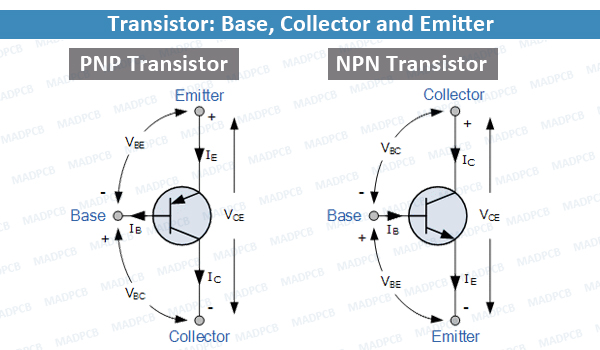What is an Emitter in Transistor?
Emitter in a transistor is the heavily doped region as compared two base and collector, to supply charge carrier to the collector via the base.
Transistors are composed of three parts:
- Base: the base is the gate controller device for the larger electrical supply.
- Collector: the collector is the larger electrical supply.
- Emitter: the emitter is the outlet for that electrical supply.
By sending varying levels of current from the base, the amount of current flowing through the gate from the collector may be regulated. In this way, a very small amount of current may be used to control a large amount of current, as in an amplifier. The same process is used to create the binary code for the digital processor but in this case a voltage threshold of five volts is needed to open the collector gate. In this way, the transistor is being used as a switch with a binary function: five volts – ON, less than five volts – OFF.

Transistor: Base, Collector and Emitter
Semiconductive materials are what make the transistor possible. Most people are familiar with electrically conductive and non-conductive materials. Metals are typically thought of as being conductive. Materials, such as wood, plastics, glass and ceramics are non-conductive, or insulators. In the late 1940’s a team of scientists working at Bell Labs in New Jersey, discovered how to take certain types of crystals and use them as electronic control devices by exploiting their semiconductive properties. Most non-metallic crystalline structures would typically be considered insulators. But by forcing crystals of germanium or silicon to grow with impurities, such as boron or phosphorus, the crystals gain entirely different electrical conductive properties. By sandwiching this material between two conductive plates (the emitter and the collector), a transistor is made. By applying current to the semiconductive material (base), electrons gather until an effectual conduit is formed allowing electricity to pass. The scientists that were responsible for the invention of the transistor were John Bardeen, Walter Brattain, and William Shockley. Their paten was called: ‘Three Electrode Circuit Element Utilizing Semiconductive Materials.’
There are two main types of transistors, including Junction Transistors and Field Effect Transistors (FETs). Each works in a different way. But the usefulness of any transistor comes from its ability to control a strong current with a weak voltage. For example, transistors in a public address system amplify (strengthen) the weak voltage produced when a person speaks into a microphone. The electricity coming from the transistors is strong enough to operate a loudspeaker, which produces sounds much louder than the person’s voice.
Junction Transistors
A junction transistor consists of a thin piece of one type of semiconductor material between two thicker layers of the opposite type. For example, if the middle layer is p-type, the outside layers must be n-type. Such a transistor is an NPN transistor. One of the outside layers is called the emitter, and the other is known as the collector. The middle layer is the base. The places where the emitter joins the base and the base joins the collector are called junctions.
The layers of an NPN transistors must have the proper voltage connected across them. The voltage of the base must be more positive than that of the emitter. The voltage of the collector, in turn, must be more positive than that of the base. The voltages are supplied by a battery or some other source of direct current. The emitter supplies electrons. The base pulls these electrons from the emitter because it has a more positive voltage than does the emitter. This movement of electrons creates a flow of electricity through the transistor.
The current passes from the emitter to the collector through the base. Changes in the voltage connected to the base modify the flow of the current by changing the number of electrons in the base. In this way, small changes in the base voltage can cause large changes in the current flowing out of the collector.
Manufacturers also make PNP junction transistors. In these devices, the emitter and collector are both a p-type semiconductor material and the base is n-type. A PNP junction transistor works on the same principle as an NPN transistor. But it differs in one respect. The main flow of current in a PNP transistor is controlled by altering the number of holes rather than the number of electrons in the base. Also, this type of transistor works properly only if the negative and positive connections to it are the reverse of those of the NPN transistor.
Field Effect Transistors
A field effect transistor has only two layers of semiconductor material, one on top of the other. Electricity flows through one of the layers, called the channel. A voltage connected to the other layer, called the gate, interferes with the current flowing in the channel. Thus, the voltage connected to the gate controls the strength of the current in the channel. There are two basic varieties of field effect transistors-the junction field effect transistor (JFET) and the metal oxide semiconductor field effect transistor (MOSFET). Most of the transistors contained in today’s integrated circuits are MOSFETS’s.
